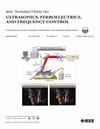A Unified Framework Combining Doppler-Based Motion Compensation, Harmonic Imaging, and Angular Coherence for High-Quality B-Mode in Ultrafast Echocardiography
IF 3
2区 工程技术
Q1 ACOUSTICS
IEEE transactions on ultrasonics, ferroelectrics, and frequency control
Pub Date : 2024-12-11
DOI:10.1109/TUFFC.2024.3505060
引用次数: 0
Abstract
Various methods have been proposed to enhance image quality in ultrafast ultrasound. Coherent compounding can improve image quality using multiple steered diverging transmits when motion occurring between transmits is corrected. Harmonic imaging has been adapted for ultrafast imaging to reduce clutter. Coherence-based approaches have also been shown to increase contrast in clinical settings by enhancing signals from coherent echoes. Herein, we introduce a simple, unified framework that combines motion correction, harmonic imaging, and angular coherence, showing for the first time that their benefits can be combined in real time. To do so, harmonic imaging was achieved through pulse inversion (PI), phase delay between successive transmits was assessed to perform motion compensation (MoCo), and ensemble autocorrelation between transmits was used to generate a weight applied to the coherently compounded frames. Validation was conducted through in vitro testing on a spinning disk model and in vivo on four volunteers. In vitro results confirmed the unified framework capability to achieve high contrast in large-motion contexts up to 17 cm/s. In vivo testing highlighted proficiency in generating images of high quality during low and high tissue velocity phases of the cardiac cycle. Specifically, during ventricular filling, the unified framework increased the generalized contrast-to-noise ratio (gCNR) from 0.47 to 0.87 when compared against coherent compounding.结合基于多普勒的运动补偿、谐波成像和角相干的超快超声心动图高质量b模统一框架
为了提高超快超声图像质量,人们提出了多种方法。在校正传输间的运动后,利用多方向发散传输进行相干复合可以提高图像质量。谐波成像已被用于超快成像,以减少杂波。基于相干的方法也被证明可以通过增强相干回声的信号来增加临床环境中的对比度。本文介绍了一个简单、统一的框架,结合了运动校正、谐波成像和角相干性,首次展示了它们的优点可以实时结合在一起。为此,通过脉冲反转(PI)实现谐波成像,评估连续传输之间的相位延迟以执行运动补偿(MoCo),并使用传输之间的集合自相关来生成应用于相干复合帧的权值。通过旋转盘模型的体外实验和4名志愿者的体内实验进行验证。体外结果证实了统一框架能够在高达17 cm/s的大运动环境中实现高对比度。体内测试强调了在心脏周期的低和高组织速度阶段生成高质量图像的熟练程度。具体而言,在心室填充期间,与相干复合相比,统一框架将广义噪比(gCNR)从0.47提高到0.87。
本文章由计算机程序翻译,如有差异,请以英文原文为准。
求助全文
约1分钟内获得全文
求助全文
来源期刊
CiteScore
7.70
自引率
16.70%
发文量
583
审稿时长
4.5 months
期刊介绍:
IEEE Transactions on Ultrasonics, Ferroelectrics and Frequency Control includes the theory, technology, materials, and applications relating to: (1) the generation, transmission, and detection of ultrasonic waves and related phenomena; (2) medical ultrasound, including hyperthermia, bioeffects, tissue characterization and imaging; (3) ferroelectric, piezoelectric, and piezomagnetic materials, including crystals, polycrystalline solids, films, polymers, and composites; (4) frequency control, timing and time distribution, including crystal oscillators and other means of classical frequency control, and atomic, molecular and laser frequency control standards. Areas of interest range from fundamental studies to the design and/or applications of devices and systems.

 求助内容:
求助内容: 应助结果提醒方式:
应助结果提醒方式:


